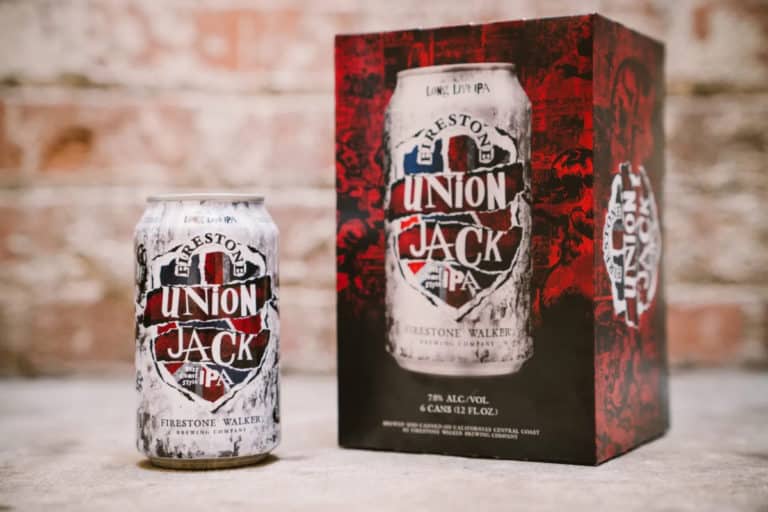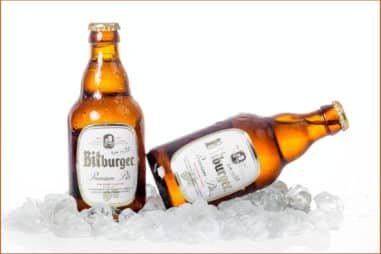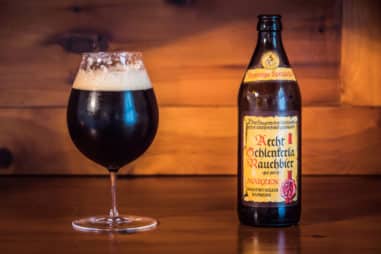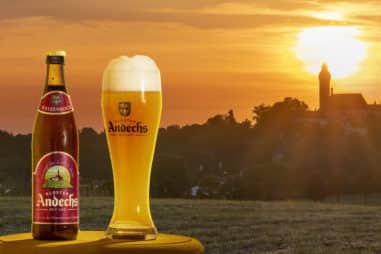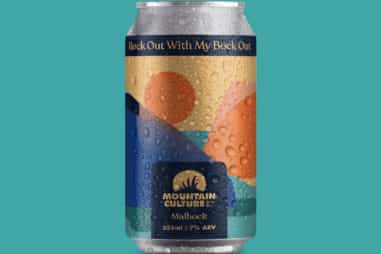There’s a lot more character to West Coast Style IPAs than simply getting a bitter bite of beer.
In this guide, you’ll learn everything there is to know about West Coast IPAs, the brewing process, and great West Coast IPAs to try.
What Does West Coast IPA Mean?
When brewers say West Coast IPA, it means high bitterness, bold hoppy aroma, and citrus or piney resin flavors.
By tradition, West Coast IPAs will typically have those 3 qualities. However, the hops and malts used to brew a West Coast IPA can also influence the taste.
As you’ll find out in the later sections, there are several hops you can use to make a West Coast Style IPA.
Other factors include the mash pH, brewing technique, temperature, grain bill or malts used, and yeast strains.
Why Is It Called a West Coast IPA?
The term “West Coast” was added because most of the breweries brewed West Coast IPAs in various states along the Pacific Ocean.
During this time, breweries also used the hops that were largely grown in this area, which gave rise to the name West Coast IPAs.
What Makes a Beer a West Coast IPA?
There are 3 important qualities that make a beer a West Coast IPA:
- A distinct bitterness is achieved by adding hops during the kettle boil or early in the boiling process
- A dry and crisp profile
- High hop aroma and citrus flavors
To achieve these qualities, it’s not just the brewing process that matters. The base malt and specialty grains also contribute to the distinct characteristics of a West Coast IPA.
What Makes a West Coast IPA Different?
One of the most significant differences you’ll find in a West Coast IPA compared to other IPAs is its brewing process.
Because a large number of hops are added early during the boil, it’s hard for anyone’s palate to miss the bitter bite of a West Coast IPA.
Yes — West Coast Style IPAs are bitter, citrusy, and hoppy.
Compared to East Coast IPAs, Hazy IPAs, or New England IPAs, West Coast Style IPAs are all about hops and bitterness. East Coast IPAs and Hazy IPAs are more fruity, sweeter, and have a restrained or soft bitterness.
New England IPAs (NEIPAs) are in the simplest definition … juice bombs. These IPAs still have hoppy, malty, and soft bitter qualities, make no mistake. However, NEIPAs take the fruity and juicy flavors to the next level. To give you a better example, it’s like biting into ripe fruit.
What Is a West Coast Double IPA?
If West Coast IPAs are bitter and hoppy, does that mean a West Coast Double IPA has double the bitterness and hoppiness?
You’re absolutely right! West Coast Double IPAs are bolder, have stronger hop aromas, and, typically, slightly more bitterness.
But there’s one more quality to West Coast Double IPAs you’re missing: the ABV or alcohol by volume.
West Coast IPAs usually have an ABV of 5.5% to 7.5%. West Coast Double IPAs are nearly double the ABV, coming in at 7.5% to 10%!
Phew! Talk about a 6-pack tipsy feeling. One thing to note as well is the IBU, or International Bitterness Units.
Now the name sounds technical and all, but it really just means the amount or number of bitter compounds in beer. The higher the IBU, the more bitter it is.
So how many IBUs does a West Coast IPA have? Around 40 to 70 IBUs. Can you guess how many a West Coast Double IPA has?
You’re right. Nearly double that amount too at around 60 to 120 IBUs.
What Do West Coast IPAs Taste Like?
Big, bold, and bitter is what some would say if you asked what a West Coast IPA tastes like. However, if West Coast IPAs were just plain old bitter beers, that would be boring and dull.
West Coast IPAs also have citrus and tropical flavors. Think peppery pine, grapefruit peels, and lemon rinds.
Not so bad now, is it? As for the mouthfeel, West Coast IPAs have a thin body and overall mouthfeel because it’s meant to deliver a dry, crisp profile.
Granted, West Coast IPAs don’t exactly fall under the category of easy-drinking beers, but they are delicious. After all, bitter tastes are a sensation you aren’t trained to naturally digest.
Our brains tend to associate bitterness with poison, so there’s bound to be resistance. And the more you drink West Coast Style IPAs, the more your brain becomes accustomed to its bitterness.
In fact, West Coast Double IPAs came to be because some got so used to the flavors and hoppiness of a West Coast IPA. So what did they demand for? More hops. And that’s what happened.
Are West Coast IPAs Fruity?
West Coast IPAs have fruity notes and aromas, however, it’s not as prominent compared to, say, East Coast IPAs.
Remember: West Coast IPAs highlight bitterness overall. Most of the other citrus, tropical, or fruity notes you might taste take the backseat in a West Coast IPA.
Although West Coast IPAs have fruity flavors, it wouldn’t feel right to say that West Coast IPAs are fruity.
Are West Coast IPAs Piney?
Now that’s something that matches a West Coast IPA.
Piney, citrus, grapefruit, and even dank flavors are the closest flavor associations of West Coast IPAs. Fruity? not so much. Tropical? Hmmm … maybe a little bit. Citrus and piney? Hell yes!
Are West Coast IPAs Filtered?
The short answer? Yes.
Now you’re probably wondering why. Back in the day, filtered beer was a sign of purity and fine quality. With filtered beer, you get a clear and bright appearance that supposedly symbolizes the purity of the beer.
But even though appearances make good impressions, that doesn’t mean West Coast IPAs are filtered solely for appearance.
Filtered beer is also referred to as the process of clarifying beer. It removes any leftover yeast or excess polyphenols (aroma) and extends the shelf life of beer.
The latter is a more common reason as to why beer is clarified. Extending the shelf life of beer means preserving the flavors, aroma, and freshness longer.
Who wouldn’t want that right? And as a bonus, you get crystal clear beer.
Can West Coast IPA Be Hazy?
So you’ve heard about the haze craze? Hazy IPAs are booming in nearly every state and corner of every brewery in the beer industry.
Does that mean West Coast IPAs are going to follow that trend? It’s a hard no. West Coast IPAs aren’t backing down because of some hazy craze phenomenon. Still, you might stumble onto a West Coast IPA with some haziness to it, but at very minuscule amounts.
Can West Coast IPAs be hazy? Sure they can, but that doesn’t mean they should be.
If West Coast IPAs were as hazy as Hazy IPAs, then there wouldn’t be any clear distinction between the two. It’s worth noting, though, that modern West Coast IPAs are allowed to be unfiltered.
That means modern styles today don’t mind adding a little haze. Don’t worry, this small haziness wouldn’t hurt the pride and oh-so-classic profiles of a West Coast IPA.
How Do You Make a Good West Coast IPA?
Great question.
And because you asked, expect this to be one hell of a section. To make a good West Coast IPA, you have to look at 5 elements:
- The base malt used
- Crystal malts
- Mash pH and temperature
- Healthy yeast
- Hop selection and character
Base Malt
Base malts make up roughly 93% to 97% of your total grain bill weight. In short, base malts lay the foundation of beer.
For West Coast IPAs, you have 3 options for your base malt selection:
Golden Promise Pale Ale Malt
Golden Promise is the gold standard of base malts for West Coast IPAs.
It’s clean, crisp, and harmonizes well with West Coast IPAs by giving it the right malty character. Brewers will often say that West Coast IPAs brewed with Golden Promise are a shelf above the rest.
American 2-Row
2-Row is a classic base malt. It’s affordable, high-quality, readily available, consistent, and easy to use. With 2-Row, you get a clean profile and high diastatic power.
What is diastatic power? It’s simply the enzymatic power of your grains or malt. The higher your diastatic power, the easier it is to break down the complex sugars in your mash into simple fermentable sugars.
And why should you care? Because if you don’t have enough diastatic power, then most of the complex sugars remain as they are. As a result, you get sweeter beer and low alcohol by volume (ABV).
If you’re still learning how to brew a West Coast IPA, you can’t go wrong with 2-Row. However, don’t let that stop you from expanding your malt horizons.
American Pilsner
And finally, American Pilsner malt.
American Pilsner is a great malt option if you want a crisp and cracker profile for your West Coast IPA. The malt profile is just right and it’s also ideal if you want your IPA to look crystal clear.
Crystal Malts
It’s always good to keep your grain bill as simple as possible, but if you want more color, flavor, or complexity, add in crystal malts.
Crystal malts balance the bitterness in West Coast IPAs, and some even impart sweet and malty flavors. Obviously, you don’t want to balance out too much of the bitterness because it wouldn’t be a West Coast IPA anymore.
You should only add about 1% to 3% of crystal malts in your overall grain bill. Some great crystal malts to use are:
- Premium English Caramalt
- Crystal Light
- Caramalt
Also, consider adding Dextrin malt to your grain bill – about 2% to 4% percent. Why? Using a base malt alone will make your IPA unbalanced and the body will be too thin.
Dextrin adds body and balances out some of the bitterness too, giving you a complex and balanced West Coast IPA.
Mash pH and Temperature
What roles do mash pH and temperature play in making a good West Coast IPA? For starters, mash temperature influences how much of the complex sugars are converted into simple sugars.
More complex sugars mean sweeter beer and a lower ABV. Mash pH is meant to prevent the extraction of any unfavorable tannins. Tannins are the bitter compounds found in your grains.
Unfavorable tannins would mean bitterness that’s way too harsh. Here are the mash pH and temperature guidelines you should follow:
- Keep your mash pH between 5.2 to 5.6. If it’s higher than 5.6, this results in the extraction of those unfavorable bitter compounds.
- Your mash temperature should be low — around 150°F (65.5°C)
Healthy Yeast
Healthy yeast is always vital to the success of brewing any kind of beer. If your yeast isn’t fresh, or contaminated due to oxygen exposure, then fermentation won’t happen.
Furthermore, yeast helps in converting sugar into alcohol, and it has a large influence on your beer’s flavor.
So what happens if you use unhealthy yeast?
You would get infected beer and off-flavors that smell and taste horribly funky. This might be a harsh alcoholic flavor or a wet paper flavor. Yikes!
Now, how do you keep your yeast healthy?
For one, always use sanitized equipment. Second, add sufficient oxygen when you’re pitching yeast (some use an oxygen stone for this). And lastly, you can add yeast nutrients during the boil to ensure your yeast is healthy.
Good yeast nutrients to use include:
- Zinc and Magnesium
- Thiamin
- Biotin
- Diammonium Phosphate
- Yeast Hulls
Hop Selection and Character
Because hops take the spotlight in West Coast IPAs, hop selection matters significantly. Combining hop varieties adds complexity and a broad hop profile to a West Coast IPA.
Would you be satisfied drinking a West Coast IPA with just a piney resin flavor? Of course not! You’d want something like piney and fruity, or tropical and piney.
In the later sections, you’ll find a guide of what hops are available to use and the flavors each imparts. Cascade is usually a preferred hop to use because it’s an all-around hop that goes well with everything.
Some hop regimens will even have hop additions every 15 minutes or so. However, this isn’t necessary. What’s important is to add hops during the kettle boil and throughout the brewing process, like after the boil.
Finally, there’s no limit to your creativity when it comes to combining hops. Of course, don’t go too crazy and just combine everything.
Brewing beer is a creative process so experiment with various flavors to discover what pairs well together and which ones don’t.
How to Brew West Coast IPA
You’re already aware that beer only requires 4 ingredients: water, yeast, grains/malt, and hops. Brewing a West Coast IPA requires the use of an ale yeast strain (more on this later) and a ton of hops.
For the hops, you have a ton of varieties to choose from. Cascade, Citra, Simcoe, Amarillo, Centennial, and Chinook are some examples.
As for the malt, the previous section mentioned the best malts to use, but here’s a quick recap. You can either use 2-Row malt, American Pilsner malt, or Golden Promise Pale Ale Malt.
Now comes the brewing process. With a West Coast IPA, you should add a ton of hops during the kettle boil.
Why? Because adding hops early during the boil extracts most of the bitterness and hoppy flavor. After all, bitterness is the signature style of West Coast IPAs.
Think of this process as similar to brewing tea.
The heat is what extracts most of the flavor found in a teabag. This works similar to how heat extracts most of the bitterness from hops in the kettle boil. As a general rule of thumb in brewing beer,
- Adding hops early during the boil is for bitterness
- Adding hops late, like during or after fermentation, are for flavor and aroma
Finally, don’t forget to add hops during the ‘whirlpool’ stage, too, as this will enhance the aroma of your IPA.
What Hops Go in a West Coast IPA?
As a guide, here are some hops worth mentioning and the flavors they impart:
- Columbus, Apollo, Tomahawk, and Zeus: Pine resin or piney flavors
- Citra: Fruity or tropical flavors
- Chinook, Centennial, Simcoe: Fruity, citrusy, or piney flavors
- Cascade, Horizon, Amarillo: Floral or citrusy flavors
- Northern Brewer and Willamette: Floral or spicy
- Glacier, Millennium, Nugget: Herbal, fruity, or spicy flavors
For bittering hops, go with Magnum, Warrior, or Summit.
When to Dry Hop West Coast IPA
Dry hopping is the process of adding hops after fermentation. For West Coast IPAs, the same principle applies.
Why dry hop after fermentation? Mainly to extract more hop aroma. However, dry hopping is also useful if you don’t want your beer to impart a lot of bitterness.
It’s more common in East Coast IPAs, Hazy IPAs, and New England IPAs. Here are a few reminders when dry hopping West Coast IPAs:
- Before adding your dry hops, make sure the temperature is at 60°F (15.5°C) to bring out most of the aroma.
- The dry hopping process should take up to 7 days maximum.
- Use a hydrometer or refractometer to test the attenuation of your beer before adding your dry hops. Aim for at least 80% attenuation. Attenuation tells you how much of the sugar was converted into alcohol. If it’s 60% attenuation, then 60% of the total sugar was converted into alcohol.
What Yeast Should I Use When Brewing a West Coast IPA?
Of course, healthy yeast as always. For the specific yeast strains, you can use either of the two:
- White Labs California Ale Yeast (WLP001)
- American Ale Yeast (Wyeast 1056)
Where Did West Coast IPAs Originate?
West Coast IPAs date back as far as the 1780s, during the height of the British Empire. When the British Empire expanded to India, they found that the climate was unfavorable for brewing traditional ales.
The journey from England to India took months, and this only added to the unfavorable conditions of brewing a traditional ale.
At the time, the only solution they could think of was to add more hops to preserve the beer’s flavor. The result? The bitter India Pale Ale you know of today.
However, this style was forgotten until the late 19th century when American craft beer became popular. Over time, American IPAs rose in popularity, and breweries sought to redefine IPAs in several ways.
One of those redefining and creative moments gave birth to West Coast IPAs along the Pacific Ocean’s coast.
Breweries along the Pacific Ocean have been brewing West Coast IPAs using the hops that were also grown in that area. One of the hops used early on was Cascade.
As the variety of hops grew, so did the flavor and profiles of West Coast IPAs.
Who Created West Coast IPA?
The first West Coast IPA created is credited to Fritz Maytag. The evolution of traditional American IPAs began in San Francisco in the year 1965.
Fritz Maytag had just purchased Anchor Brewing and sought to redefine American IPAs. He wanted to brew an English Pale Ale using American hops and a British technique — dry hopping.
At this time, Cascade was the new hop variety on the block, and so Fritz Maytag used Cascade for both the kettle boil and dry hopping.
In 1975, Fritz Maytag released Liberty Ale — the first West Coast IPA! When homebrewing was legalized in 1978, this inspired many to push the boundaries of style and flavor and take IPAs to new heights.
What Happened to West Coast IPA?
There’s no doubt West Coast IPAs took the beer industry by storm after its first debut. During the early 2000s, West Coast IPAs were widely popular.
So, what changed? The rise of New England IPAs (NEIPAs) and Hazy IPAs. Now, how exactly did these new beer styles change the West Coast IPA game?
For starters, NEIPAs and Hazy IPAs have a soft or restrained bitterness, making it easier and more enjoyable to drink. Second, the fruit-froward hops make it a juicy IPA full of appealing fruity and tropical flavors.
Third, breweries specializing in brewing NEIPAs and Hazy IPAs started popping up. Some of these breweries include:
- Monkish
- Trillium
- Tree House
- The Veil
- Weldwerks
- Other Half
Fourth, these breweries introduced pop art labels into their packaging. This added a collectability fixation of NEIPA and Hazy IPA fans.
And lastly, hop farmers started to grow juicier hops and varieties that matched the juicy & tropical flavors of NEIPAs and Hazy IPAs.
Does this mean the end of West Coast IPAs? Not at all! In fact, modern West Coast IPAs aren’t bitter bombs anymore. Back then, breweries would compete for which IPA had the highest IBU. Now? It’s more of elevating flavors in a West Coast IPA using new fruity hop varieties.
Where Is West Coast IPA Made Today?
West Coast IPAs aren’t made solely along the West Coast anymore. Breweries all across the U.S. make West Coast IPAs.
Here’s a list of where West Coast IPAs are made today:
“Ohio; California; San Francisco; Miami; Colorado; Bronx, New York; Denver; Massachusetts; Wisconsin; Houston; San Diego; Oregon; Minnesota”
Who Makes West Coast IPA?
There are several breweries that make West Coast IPAs, such as:
“Ballast Point Brewing Company, Green Flash Brewing Company, Maine Beer Company, Surly Brewing Company, Firestone Walker Brewing, Weldwerks Brewing Co., Sun King Brewery, Port Brewing Company, Beachwood BBQ & Brewing, Uiltje Brewing Company, Satyr Brews, The Brew Kettle, Laurelwood Brewing Co., Cellarmaker Brewing Company, Lagunitas Brewing Company”
and so much more!
Is Lagunitas IPA a West Coast IPA?
Great news! Lagunitas IPA is a West Coast IPA that’s available all year round! What’s interesting is the chock-full dose of caramel malted barley used to add depth and complexity to its flavor.
Combine that with its piney and citrusy flavors, and you have a West Coast IPA worth every sip. If you’re wondering what hops were used to brew Lagunitas IPA, they used Centennial, Cascade, Chinook, and Simcoe.
What Are Good West Coast IPAs to Try?
Make no mistake, Lagunitas West Coast IPA is definitely worth trying. But if you’re looking to stock up on a few more, these West Coast IPAs are worth buying.
| West Coast IPAs to Try | Brewery |
| Ballast Point Sculpin IPA | Ballast Point Brewing Company |
| Fat Head’s Head Hunter IPA | Fat Head’s Brewery |
| Maine Beer Lunch IPA | Maine Beer Company |
| Union Jack IPA | Firestone Brewing Company |
| Surly Overrated West Coast Style IPA | Surly Brewing Company |
| Pure Hoppiness | Alpine Beer Company |
| Laurelwood Workhorse IPA | Laurelwood Brewing Co. |
| Satyr Brews Menace IPA | Satyr Brews |
| Amager Batch 1000 | Amager Bryghus |
| Palate Wrecker | Green Flash Brewing Company |
| Mystic Mama IPA | Jackie O’s Pub & Brewery |
| Port Brewing Wipeout IPA | Port Brewing Company |
| Beachwood Amalgamator | Beachwood BBQ & Brewing |

